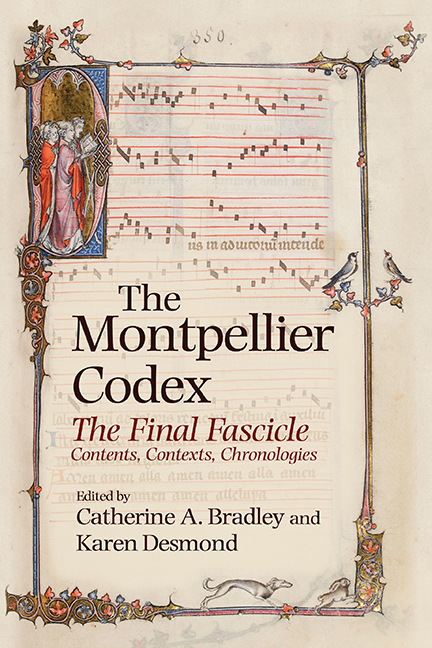Book contents
- Frontmatter
- Contents
- Figures
- Musical examples
- Tables
- Acknowledgements
- List of manuscript sigla
- Abbreviations
- Table of fascicle 8 contents
- Introduction
- I The Material Object
- II INNOVATION AND TRADITION
- 8 Texture, Rhythm, and Stylistic Groupings in Montpellier 8 Motets
- 9 Je le temoin en mon chant: The Art of Diminution in the Petronian Triplum
- 10 How Rhythmically Innovative is Montpellier 8?
- 11 Re-Presentation in the Ars antiqua: From Chant to Polyphony
- 12 … Que ne dit ‘cief bien seans’: Quoting Motets in Montpellier 8
- III ANALYTICAL CASE STUDIES
- Bibliography
- Contributors
- General index
- Index of compositions, alphabetical
- Index of compositions in Mo, manuscript order
- Miscellaneous Endmatter
8 - Texture, Rhythm, and Stylistic Groupings in Montpellier 8 Motets
from II - INNOVATION AND TRADITION
Published online by Cambridge University Press: 04 July 2019
- Frontmatter
- Contents
- Figures
- Musical examples
- Tables
- Acknowledgements
- List of manuscript sigla
- Abbreviations
- Table of fascicle 8 contents
- Introduction
- I The Material Object
- II INNOVATION AND TRADITION
- 8 Texture, Rhythm, and Stylistic Groupings in Montpellier 8 Motets
- 9 Je le temoin en mon chant: The Art of Diminution in the Petronian Triplum
- 10 How Rhythmically Innovative is Montpellier 8?
- 11 Re-Presentation in the Ars antiqua: From Chant to Polyphony
- 12 … Que ne dit ‘cief bien seans’: Quoting Motets in Montpellier 8
- III ANALYTICAL CASE STUDIES
- Bibliography
- Contributors
- General index
- Index of compositions, alphabetical
- Index of compositions in Mo, manuscript order
- Miscellaneous Endmatter
Summary
STYLISTICALLY, Mo 8 foregrounds its heterogeneity. As discussed elsewhere in this volume, the compiler(s) of Mo 8 presented a collection of motets varied in their mise en page, their poems’ languages, the nature of their cantus firmi, and their rhythmic idioms. In terms of its rhythmic techniques, Mo 8 includes some motets in a style that must have been considered quite old-fashioned by the time that the fascicle was produced (possibly as late as the 1310s, as Alison Stones and Rebecca Baltzer both propose), copied alongside others that employ some of the most recent rhythmic innovations, in particular with respect to the subdivision of the breve into multiple semibreves. In this essay, I devise a typology to describe the rhythmic language and texture of Mo 8's motets, thereby contextualizing these rhythmic techniques within the repertorial landscape of the late thirteenth and early fourteenth centuries. This typology suggests that particular rhythmic profiles may have been associated with particular sorts of motets, and that composers probably instinctively reached for certain rhythmic techniques when composing certain types of motet. Grouping Mo 8's motets according to their rhythmic behaviour reaffirms certain other genre-based criteria used for grouping them: for example, all the motets based on French chanson tenors employ a similar rhythmic profile. In addition, grouping motets according to their rhythmic profile aligns particular subsets of motets with more innovative treatments of rhythm and texture (at least considered alongside the motets copied in the so-called old corpus of the codex), possibly establishing them as among the more recent compositions of Mo 8. Finally, a comparison of some of the rhythmic profiles in Mo 8 motets with those deployed in other fourteenth-century motet collections (namely Onc and Tours) reveals a stylistic continuity between these sources, suggesting that the compilers of these various collections had similar repertories to hand.
A TYPOLOGY OF RHYTHMIC BEHAVIOUR IN MO 8
MY analysis of rhythmic behaviour focuses on the treatment of semibreves in the Mo 8 motets. The desire to more accurately prescribe how long notes could be broken up into shorter ones was a preoccupation of Ars antiqua theorists, who were writing their treatises on rhythm in polyphonic music contemporaneously with the copying and compilation of large Ars antiqua motet collections such as Mo.
- Type
- Chapter
- Information
- The Montpellier CodexThe Final Fascicle. Contents, Contexts, Chronologies, pp. 139 - 160Publisher: Boydell & BrewerPrint publication year: 2018
- 1
- Cited by

